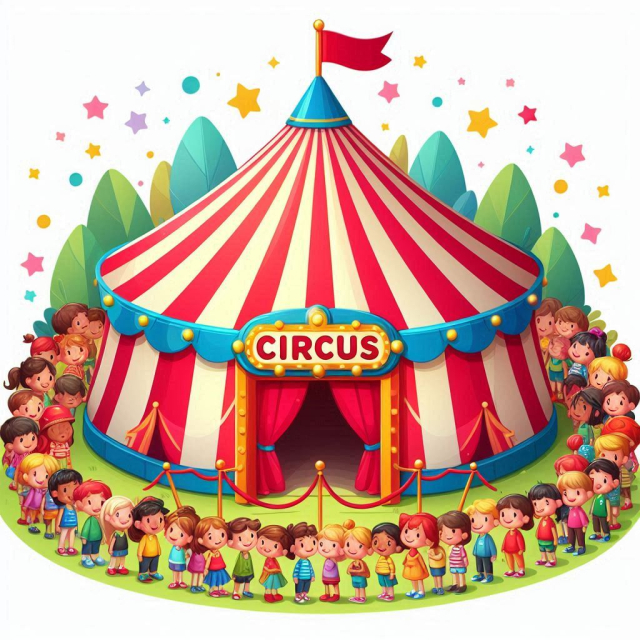Circuses have been a popular form of entertainment for centuries, capturing the imagination of audiences with their colorful and exciting performances. From their humble beginnings in ancient Rome to today's modern productions, circuses have evolved significantly. However, they have also been the subject of controversy, especially regarding animal welfare and artists' rights. This article explores the history, evolution and contemporary challenges facing circuses.
Origins of the Circus.
Ancient Rome.
The term "circus" comes from the Latin "circus", which means "circle" or "ring." In ancient Rome, the Circus Maximus was the site of grandiose competitions and spectacles that included chariot races, gladiatorial combats, and exhibitions of exotic animals. These early forms of entertainment laid the foundation for the circus concept we know today.
The Traveling Circuses of the Middle Ages.
After the fall of the Roman Empire, circuses as formal institutions disappeared, but traditions of traveling entertainment continued. During the Middle Ages, troubadours, jugglers, acrobats and animal trainers toured Europe, performing shows in market squares and festivals.
The Modern Circus.
Philip Astley and the Equestrian Circus.
The modern circus, as we know it, originated in the 18th century. In 1768, the British Philip Astley, a former cavalry officer, created a horse show in London. Astley combined horsemanship skills with other entertainment acts, such as acrobatics and clowning, and used a circular ring for his performances. This format became the standard for modern circuses.
Expansion and Diversification.
During the 19th and 20th centuries, circuses expanded and diversified. Famous circuses were established such as the Cirque d'Hiver in Paris and the Ringling Bros. and Barnum & Bailey Circus in the United States. These circuses included a variety of acts, from trapeze artists and tightrope walkers to animal shows and clowns. The circus tent became iconic, allowing circuses to travel easily and put on shows in various locations.
The Magic of Circuses.
Artists and Emblematic Acts.
Circuses have been home to countless talented performers who have performed impressive and dangerous acts. From tightrope walkers to jugglers, each act requires years of training and dedication. Clowns, with their humor and physical performances, have provided laughter and comic relief, becoming iconic symbols of circus life.
The Animals in the Circus.
One of the most controversial and fascinating aspects of circuses has been the use of animals in their shows. From elephants and lions to horses and dogs, animals have played a central role in many circuses. However, this has also raised concerns and debates about the welfare and ethical treatment of animals.
Controversies and Challenges.
Animal welfare.
The use of animals in circuses has been one of the most criticized areas. Over the years, numerous reports and documentaries have emerged highlighting the inadequate conditions and mistreatment that many animals suffer in circuses. This has led to a growing movement to ban the use of animals in circuses and a shift toward shows that focus solely on human abilities.
Rights of Artists.
Another important challenge is the well-being of circus performers. Artists often face difficult working conditions, including intense schedules, lack of job security, and physical risks. Despite these challenges, many circus performers show incredible passion and dedication to their art.
Adaptation in the Modern Era.
In the 21st century, traditional circuses face competition from other forms of entertainment, such as film, television, and video games. Additionally, growing awareness of animal welfare and worker rights has led to a decline in the popularity of circuses that use animals.
The Evolution towards a Modern and Ethical Circus.
Cirque du Soleil: A New Paradigm.
One of the most significant transformations in the world of circus was the creation of Cirque du Soleil in 1984. Founded in Canada, this circus revolutionized the industry by eliminating animal acts and focusing on human talent. With theatrical shows, impressive acrobatics and a strong artistic narrative, Cirque du Soleil has set a new standard for modern circuses.
Circuses without Animals.
Following the example of Cirque du Soleil, many other circuses have chosen to eliminate animal acts. These circuses focus on acrobatics, juggling, dance, and other forms of human entertainment. This transition not only addresses ethical concerns about the treatment of animals, but also allows circuses to attract modern audiences seeking more conscious and responsible forms of entertainment.
New Technologies and Experiences.
Modern circuses are also incorporating new technologies to create unique and immersive experiences. From advanced lighting effects to holographic projections and augmented reality, technology is transforming the way circuses present their shows. These innovations not only improve the audience experience, but also allow circuses to differentiate themselves in a competitive entertainment market.
The Future of Circuses.
Sustainability and Social Responsibility.
As society becomes more aware of sustainability and social responsibility, circuses are also adapting their practices to be more respectful of the environment and their performers. This includes using sustainable materials, implementing fair labor practices and promoting animal welfare.
Education and formation.
Circuses also play an important role in education and artistic training. Many circus schools around the world offer rigorous training programs for young performers, providing a platform to develop exceptional skills and talents. These institutions help preserve circus traditions while fostering innovation and creativity.
Community and Culture.
Beyond entertainment, circuses also have a significant impact on community and culture. They often serve as a space for inclusion and diversity, where people from different backgrounds and cultures can come together to create and enjoy art. Circuses can also play a role in revitalizing urban areas and promoting cultural tourism.
Circuses have come a long way from their origins in ancient Rome to becoming a global art and entertainment form. Despite challenges and controversies, circuses continue to evolve and adapt to modern times. With a renewed focus on ethics, sustainability and innovation, the circus continues to be a source of wonder and joy for audiences of all ages around the world.
